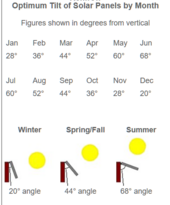In my research so far I've gotten many different answers. From 45 degrees to 18 degrees from vertical and everywhere in between.
We currently have 1200watts of panels roof mounted at something like 20 degrees which meets our needs in the summer as it was designed for. But now my parents have been enjoying the winter there, they have to run the generator every evening. The current system has already paid for itself in generator gas savings. So we are ready to reinvest in a much larger system. The current system is 12v and doesn't really have any room to grow. So I'm building a whole new 48v system to run in parallel. The existing system will continue to run the 12v fridge, water pump and lights. The new system will take over all the 120v loads(Starlink, TV, small kitchen appliances, etc..) and be able to charge the 12v system as needed. I've got a line on 8x545watt bifacial panels for 4360watts which is over 3 times what we have now. I'm planning on a EG4 3000watt inverter/charge controller(3000EHV-48) and 2 EG4 rack mount batteries(~10kWh of storage).
I'm not really concerned about summer production at all. We already have enough in the existing system. The biggest constant draw on this system will be Starlink. It's the short grey days of winter I'm concerned about collecting enough power. We will expect to occasionally have to run a generator if we have a few days of very grey skys.
Snow is somewhat minimal and doesn't seem to stick around any more. But we can still get snow from December through April.
We are leaning more towards having this array mounted on a shed rather than ground mounted. Which will diminish the advantage of bifacial panels somewhat, but they are actually slightly cheaper than regular panels through my supplier. We get very high winds on our property(200km/h). We need to build a shed anyway and know how to build a shed to handle the wind. We would build the roof so that one side is at this optimum angle, clad in white metal and the panels mount something like 4ft off the ground to keep them well above the snow which typically can drift 2-3'.
I would really like to see some data from a similar latitude testing different angles and showing production on grey winter days.
We currently have 1200watts of panels roof mounted at something like 20 degrees which meets our needs in the summer as it was designed for. But now my parents have been enjoying the winter there, they have to run the generator every evening. The current system has already paid for itself in generator gas savings. So we are ready to reinvest in a much larger system. The current system is 12v and doesn't really have any room to grow. So I'm building a whole new 48v system to run in parallel. The existing system will continue to run the 12v fridge, water pump and lights. The new system will take over all the 120v loads(Starlink, TV, small kitchen appliances, etc..) and be able to charge the 12v system as needed. I've got a line on 8x545watt bifacial panels for 4360watts which is over 3 times what we have now. I'm planning on a EG4 3000watt inverter/charge controller(3000EHV-48) and 2 EG4 rack mount batteries(~10kWh of storage).
I'm not really concerned about summer production at all. We already have enough in the existing system. The biggest constant draw on this system will be Starlink. It's the short grey days of winter I'm concerned about collecting enough power. We will expect to occasionally have to run a generator if we have a few days of very grey skys.
Snow is somewhat minimal and doesn't seem to stick around any more. But we can still get snow from December through April.
We are leaning more towards having this array mounted on a shed rather than ground mounted. Which will diminish the advantage of bifacial panels somewhat, but they are actually slightly cheaper than regular panels through my supplier. We get very high winds on our property(200km/h). We need to build a shed anyway and know how to build a shed to handle the wind. We would build the roof so that one side is at this optimum angle, clad in white metal and the panels mount something like 4ft off the ground to keep them well above the snow which typically can drift 2-3'.
I would really like to see some data from a similar latitude testing different angles and showing production on grey winter days.



